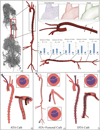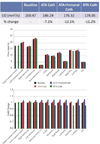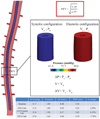An Experimental-Computational Study of Catheter Induced Alterations in Pulse Wave Velocity in Anesthetized Mice
- PMID: 25698526
- PMCID: PMC4497847
- DOI: 10.1007/s10439-015-1272-0
An Experimental-Computational Study of Catheter Induced Alterations in Pulse Wave Velocity in Anesthetized Mice
Abstract
Computational methods for solving problems of fluid dynamics and fluid-solid-interactions have advanced to the point that they enable reliable estimates of many hemodynamic quantities, including those important for studying vascular mechanobiology or designing medical devices. In this paper, we use a customized version of the open source code SimVascular to develop a computational model of central artery hemodynamics in anesthetized mice that is informed with experimental data on regional geometries, blood flows and pressures, and biaxial wall properties. After validating a baseline model against available data, we then use the model to investigate the effects of commercially available catheters on the very parameters that they are designed to measure, namely, murine blood pressure and (pressure) pulse wave velocity (PWV). We found that a combination of two small profile catheters designed to measure pressure simultaneously in the ascending aorta and femoral artery increased the PWV due to an overall increase in pressure within the arterial system. Conversely, a larger profile dual-sensor pressure catheter inserted through a carotid artery into the descending thoracic aorta decreased the PWV due to an overall decrease in pressure. In both cases, similar reductions in cardiac output were observed due to increased peripheral vascular resistance. As might be expected, therefore, invasive transducers can alter the very quantities that are designed to measure, yet advanced computational models offer a unique method to evaluate or augment such measurements.
Figures






Similar articles
-
An invasive but simple and accurate method for ascending aorta-femoral artery pulse wave velocity measurement.Blood Press. 2013 Feb;22(1):45-50. doi: 10.3109/08037051.2012.694255. Epub 2012 Jul 3. Blood Press. 2013. PMID: 22747433
-
Pulse Wave Velocity Prediction and Compliance Assessment in Elastic Arterial Segments.Cardiovasc Eng Technol. 2015 Mar;6(1):49-58. doi: 10.1007/s13239-014-0202-x. Epub 2014 Dec 6. Cardiovasc Eng Technol. 2015. PMID: 26577102
-
Arterial pulse wave velocity measurement: different techniques, similar results--implications for medical devices.Biomech Model Mechanobiol. 2010 Dec;9(6):773-81. doi: 10.1007/s10237-010-0213-y. Epub 2010 Apr 7. Biomech Model Mechanobiol. 2010. PMID: 20372959
-
Clinical measurement of arterial stiffness obtained from noninvasive pressure waveforms.Am J Hypertens. 2005 Jan;18(1 Pt 2):3S-10S. doi: 10.1016/j.amjhyper.2004.10.009. Am J Hypertens. 2005. PMID: 15683725 Review.
-
Arterial elastance and wave reflection augmentation of systolic blood pressure: deleterious effects and implications for therapy.J Cardiovasc Pharmacol Ther. 2001 Jan;6(1):5-21. doi: 10.1177/107424840100600102. J Cardiovasc Pharmacol Ther. 2001. PMID: 11452332 Review.
Cited by
-
Heterogeneous mechanics of the mouse pulmonary arterial network.Biomech Model Mechanobiol. 2016 Oct;15(5):1245-61. doi: 10.1007/s10237-015-0757-y. Epub 2016 Jan 20. Biomech Model Mechanobiol. 2016. PMID: 26792789 Free PMC article.
-
Measuring Arterial Stiffness in Animal Experimental Studies.Arterioscler Thromb Vasc Biol. 2020 May;40(5):1068-1077. doi: 10.1161/ATVBAHA.119.313861. Epub 2020 Apr 9. Arterioscler Thromb Vasc Biol. 2020. PMID: 32268787 Free PMC article. Review.
-
Comparative Study of Human and Murine Aortic Biomechanics and Hemodynamics in Vascular Aging.Front Physiol. 2021 Oct 25;12:746796. doi: 10.3389/fphys.2021.746796. eCollection 2021. Front Physiol. 2021. PMID: 34759837 Free PMC article.
-
Patient-Specific Modeling of Hemodynamics: Supporting Surgical Planning in a Fontan Circulation Correction.J Cardiovasc Transl Res. 2018 Apr;11(2):145-155. doi: 10.1007/s12265-017-9781-x. Epub 2018 Jan 8. J Cardiovasc Transl Res. 2018. PMID: 29313269 Review.
-
Experimental and Mouse-Specific Computational Models of the Fbln4SMKO Mouse to Identify Potential Biomarkers for Ascending Thoracic Aortic Aneurysm.Cardiovasc Eng Technol. 2022 Aug;13(4):558-572. doi: 10.1007/s13239-021-00600-4. Epub 2022 Jan 22. Cardiovasc Eng Technol. 2022. PMID: 35064559 Free PMC article.
References
-
- Baek S, Gleason RL, Rajagopal KR, Humphrey JD. Theory of small on large: Potential utility in computations of fluid–solid interactions in arteries. Comput. Methods Appl. Mech. Eng. 2007;196:3070–3078.
-
- Bramwell JC, Hill AV. The Velocity of the Pulse Wave in Man. Proc. R. Soc. B Biol. Sci. 1922;93:298–306.
-
- Claeys MA, Gepts E, Camu F. Haemodynamic changes during anaesthesia induced and maintained with propofol. Br. J. Anaesth. 1988;60:3–9. - PubMed
-
- Feintuch A, Ruengsakulrach P, Lin A, Zhang J, Zhou Y-Q, Bishop J, Davidson L, Courtman D, Foster FS, a Steinman D, Henkelman RM, Ethier CR. Hemodynamics in the mouse aortic arch as assessed by MRI, ultrasound, and numerical modeling. Am. J. Physiol. Heart Circ. Physiol. 2007;292:H884–H892. - PubMed
Publication types
MeSH terms
Grants and funding
LinkOut - more resources
Full Text Sources
Other Literature Sources
Research Materials

